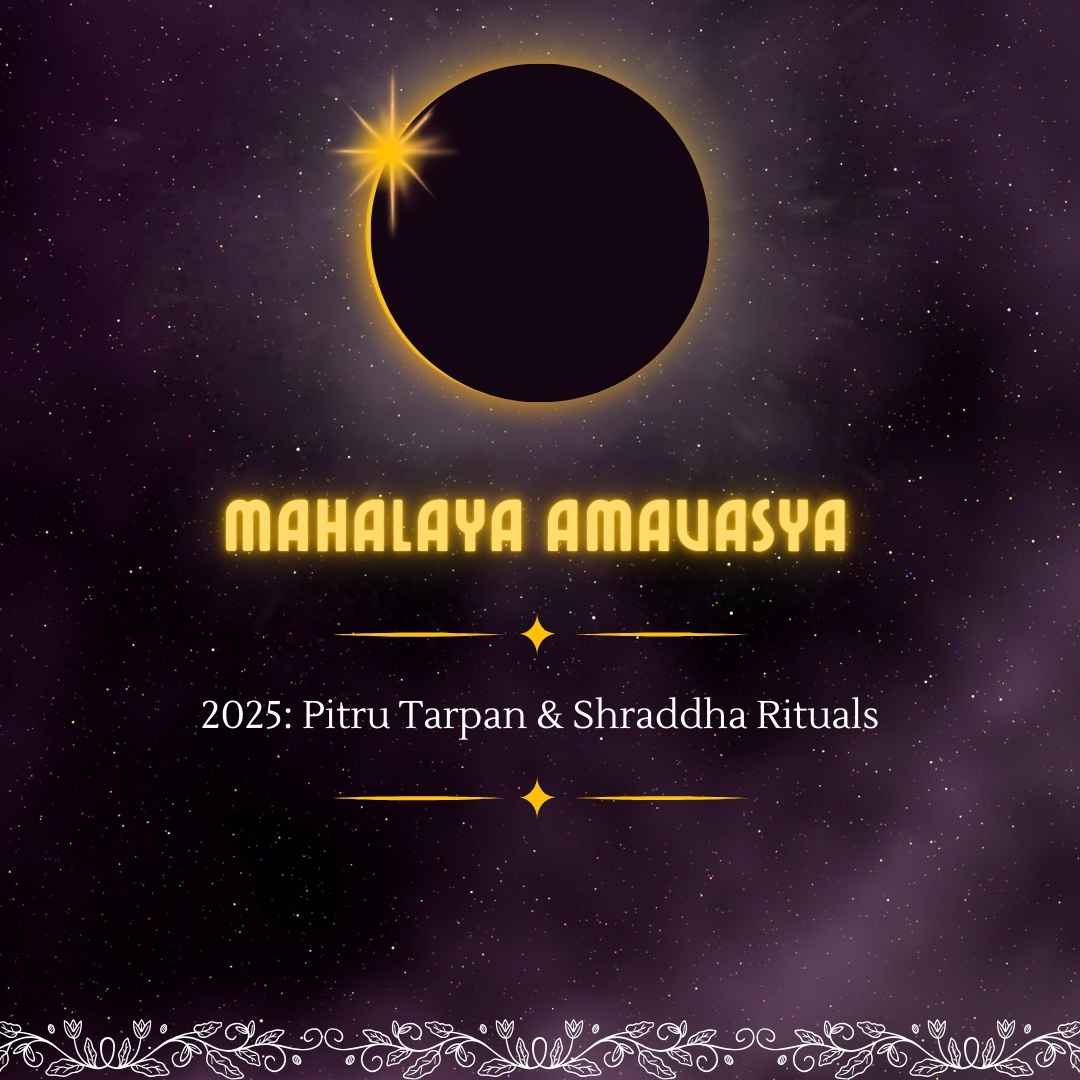Mahalaya Amavasya 2025 marks a deeply spiritual day in the Hindu calendar, observed with great reverence by devotees across India. It is regarded as a highly auspicious occasion dedicated to honoring one’s ancestors through rituals like Pitru Tarpan and Shraddha, ensuring peace for their souls and blessings for descendants. This sacred day also holds special importance as it ushers in the vibrant celebrations of Sharad Navratri, linking the remembrance of forefathers with the worship of the Divine Mother.
In 2025, Mahalaya Amavasya will be observed on 22nd September (Monday). On this day, devotees perform rituals on the banks of holy rivers, visit temples, and conduct Shraddha ceremonies at home or with the help of priests.
Also read- Festival in October 2025: Complete List of Hindu Festivals
Date and Timings of Mahalaya Amavasya 2025
According to the Hindu calendar, Mahalaya Amavasya falls on the Amavasya Tithi (new moon day) of the month of Bhadrapada or Ashwin, depending on the regional calendar system. It marks the concluding day of Pitru Paksha (fortnight of the ancestors).
- Mahalaya Amavasya 2025 Date: Monday, 22nd September 2025
- Amavasya Tithi Begins: 6:24 PM, September 21, 2025
- Amavasya Tithi Ends: 8:05 PM, September 22, 2025
Shraddha rituals are usually performed in the morning, after sunrise and before midday (the Kuthapaka kaal), which is considered the most auspicious time.
Read about – Masik Shivratri October 2025: Puja Vidhi & Night Fasting
Read about – Skanda Sashti 2025: Murugan Puja Vidhi & Significance
The Spiritual Significance of Mahalaya Amavasya
Mahalaya Amavasya carries profound spiritual meaning in Hindu dharma. It is believed that ancestors (Pitrs) descend to the earthly realm during the Pitru Paksha period. On the final day, Mahalaya Amavasya, their souls are especially receptive to offerings made by their descendants. Performing Shraddha and Tarpan on this day not only satisfies them but also invites their blessings for family prosperity and spiritual elevation.
Key aspects of its significance include:
- Ritual of Gratitude: It is the ultimate act of honoring forefathers. By offering food, water, and prayers, one acknowledges the lineage and expresses gratitude.
- Liberation of Souls: Scriptures mention that ancestors attain moksha (liberation) when descendants perform the prescribed rituals with sincerity.
- Removal of Pitru Dosha: Performing Shraddha on this occasion helps pacify Pitru Dosha in one’s horoscope, which otherwise may cause obstacles in life, marriage, progeny, or prosperity.
- Balance of Life Cycles: By honoring ancestors before Navratri begins, devotees symbolically connect the departed souls with divinity, harmonizing worldly and spiritual duties.
Mythological Legends Behind Mahalaya Amavasya
Several powerful legends from Hindu scriptures add eternal depth to Mahalaya Amavasya.
Karna’s Vrat and Pitru Lok
One of the most famous stories is linked to Maharathi Karna. After his death in the Mahabharata war, Karna reached Pitru Lok where he was offered gold and jewels instead of food. Surprised, he asked why he wasn’t given food. It was then revealed that he never made offerings to his ancestors while alive. Disturbed, he was allowed to return to earth for 16 days (Pitru Paksha) to offer food and water to his ancestors. Hence, Pitru Paksha came into being.
Goddess Durga’s Descent
Another legend describes Goddess Durga’s journey to Earth, which begins with Mahalaya. Devotees believe that on Mahalaya, Mother Durga descends from Mount Kailash to her maternal home on Earth, heralding the upcoming Navratri festival. The iconic Chandipath recitation and invocation of the goddess during Mahalaya links this day not only with ancestors but also with divine feminine energy.
Thus, Mahalaya Amavasya merges two spiritual planes—the ancestral and the devotional.
Traditions of Pitru Tarpan
Pitru Tarpan is the central ritual of Mahalaya Amavasya. The word “Tarpan” means offering of water and prayers to satisfy souls. Devotees perform it either individually or under guidance of family priests.
How to Perform Tarpan
- Wake up early, bathe, and wear clean clothes.
- Sit facing south (direction of ancestors) near a river, pond, or sacred water body.
- Take black sesame seeds, rice, barley, kusa grass, and water in hand.
- Chant Pitru mantras while offering the mixture with folded hands.
- Offer Tarpan thrice—for ancestors, for forgotten ancestors, and for all departed souls.
Benefits of Tarpan
- Brings peace to ancestral souls.
- Eliminates karma-related blockages from one’s lineage.
- Grants harmony, prosperity, and protection from unseen negative influences.
Read about – Valmiki Jayanti 2025: Life & Teachings of Maharishi Valmiki
Read about – Kojagari Lakshmi Puja 2025: Overnight Vigil & Wealth Rituals
Shraddha Rituals on Mahalaya Amavasya
Shraddha means “faith,” and it involves offering food, water, and prayers to forefathers on their behalf. The ritual is detailed in the Garuda Purana, Vishnu Purana, and Manu Smriti.
Steps of Shraddha
- A Brahmin priest is invited to conduct the ritual.
- The ritual begins with Sankalpa (divine resolution) stating the family lineage, gothra, and ancestors being remembered.
- Pind Daan (offering of food balls made of rice, sesame, and ghee) is offered to ancestors.
- Brahmin priests and cows are fed in remembrance of ancestors.
- Donations and Dakshina are given as acts of charity.
Significance of Shraddha
- Ensures ancestors receive nourishment in the afterlife.
- Provides their blessings for progeny, well-being, and dharmic prosperity.
- Relieves families from ongoing generational difficulties tied to Pitru Rina (debts towards ancestors).
Regional Importance of Mahalaya Amavasya
West Bengal: A Prelude to Durga Puja
People celebrate Mahalaya most joyously in West Bengal, and they regard it as the official beginning of Durga Puja festivities. Early morning, devotees tune into the famous Mahishasura Mardini recital, a dramatic narration of Devi Durga’s victory over the demon Mahishasura. Devotees treat the day as an invitation to Goddess Durga to descend to Earth.
Tamil Nadu and Andhra Pradesh
Here, Shraddha ceremonies are observed with devotion in temples and homes. Devotees offer food to crows, symbolizing messengers of ancestors.
Bihar and Uttar Pradesh
Families gather near the Ganga ghats to perform Pitru Tarpan. Pandits conduct mass Pind Daan ceremonies in places like Gaya, and devotees regard it as the holiest site for ancestral liberation.
Maharashtra and Gujarat
Rituals center around holy rivers and temples dedicated to Lord Vishnu. People make offerings and chant mantras dedicated to ancestors.
Mahalaya Amavasya and Navratri Connection
A key reason Mahalaya Amavasya holds great reverence is its direct connection to Navratri. Immediately after this day, devotees gear up for Sharad Navratri, one of the grandest festivals celebrating Goddess Durga.
- Mahalaya signifies closing the chapter of Pitru Paksha and opening the divine chapter of Devi Paksha.
- People consider the period of Pitru Paksha inauspicious for new beginnings, but they regard its end as a symbol of fresh spiritual energy.
- By honoring ancestors before Navratri, devotees spiritually purify themselves to welcome Goddess Durga.
Thus, Mahalaya bridges the worlds of remembrance and celebration.
Scientific Perspective on Ancestor Worship
Though rooted in spiritual ideals, Mahalaya rituals also align with psychological and social science. Ancestor worship provides:
- Family Bonding: Offers a sense of unity among living family members.
- Continuity of Heritage: Transmits traditions across generations.
- Catharsis: Spiritual remembrance helps in healing grief and emotional closure.
- Environmental Harmony: Rituals performed on riverbanks promote collective awareness of nature’s sacredness.
Major Pilgrimage Sites for Mahalaya Rituals
Some holy places associated with Pitru Tarpan and Shraddha attract thousands on Mahalaya:
- Gaya (Bihar): The foremost destination for Pind Daan.
- Varanasi (UP): Sacred Ganga ghats ideal for Pitru Tarpan.
- Prayagraj: Confluence of Ganga-Yamuna-Saraswati is highly auspicious.
- Rameswaram (Tamil Nadu): Popular site for ancestral rituals.
- Haridwar: Known for Shraddha at Har-ki-Pauri ghats.
Mahalaya Amavasya 2025 is a day that beautifully unites spirituality, tradition, and devotion. On this sacred occasion, Hindus honor their ancestors with Shraddha and Pitru Tarpan rituals, seeking blessings for peace, prosperity, and balance in life. At the same time, it signifies the divine arrival of Goddess Durga and the beginning of Navratri celebrations.
By observing Mahalaya Amavasya with dedication, one not only respects the eternal lineage of forefathers but also prepares spiritually for the path of righteousness symbolized by the worship of the Divine Mother.
As Mahalaya 2025 approaches, let us take this opportunity to honor our Pitrs, follow the traditional rituals, and welcome Navratri with a purified heart and soul.
Read about – Chhath Puja 2025 : Surya Arghya & Rituals



1 Comment